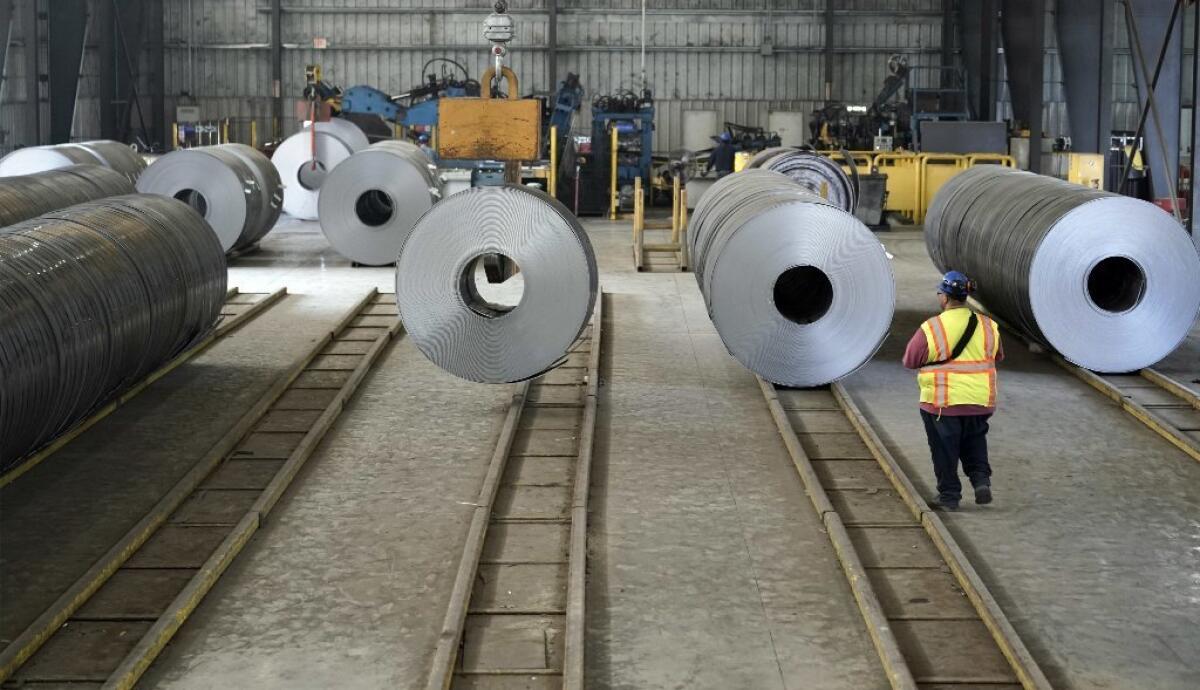The economic data don’t show it, but many U.S. firms at home and in China are feeling the pain of tariffs

Reporting from Washington — Partially masked by the percolating economy and highflying stock market, tariffs imposed by the Trump administration and retaliation by U.S. trading partners have begun to cause significant pain for a large and growing swath of U.S. businesses at home and abroad.
Companies and establishments from a broad range of industries — manufacturers, farms, construction firms, retailers, rail yards and airports — report that they are feeling the effects of higher prices or supply disruptions and putting new projects and investments on ice.
“For those firms already impacted, contacts often cited double-digit price increases; some typical responses were that tariffs ‘have put us out of business’ on certain products and ‘are a cloud on every facet of our business planning,’” the Federal Reserve Bank of Philadelphia said in a report released Wednesday.
The picture looks graver for companies operating in China, according to a separate survey conducted by the American chambers of commerce in Shanghai and Beijing and also released Wednesday.
More than 60% of the firms surveyed in August and September said that the tariffs, taxes on imports, levied on $50 billion of goods already by the U.S. and China have cost them business. One in four firms reported their profits were down more than 10% as a result.
About half of the American firms said that in addition to the tariffs, they’ve experienced an increase in other barriers in China in recent months, including stepped-up inspections and slower customs clearances. Executives at many U.S. firms fear those sorts of non-tariff barriers will spread as China seeks to counter the administration’s escalating taxes on Chinese exports to the U.S.
Kenneth Jarrett, president of the American chamber in Shanghai, where about 6,000 U.S. businesses and investments operate, was stunned by the widespread nature of the new barriers. The explanation may be “you have overzealous officials thinking they should be tougher or they’re warning they could exercise authority more firmly if they wish,” he said in an interview.
Either way, the message — which Jarrett and his chamber team intend to convey to the White House and Congress when they visit this month — is clear: “The tariffs are damaging and we want to avoid more serious damage,” he said.
Thus far, the nation’s strong economic growth, fueled in part by tax cuts and deregulation of businesses, has softened the blow for many companies. Like other economists, Michael Gapen of Barclays Bank is forecasting the U.S. economy to expand at a brisk 3% annual rate in the remaining two quarters of this year, similar to the first half. That should be strong enough for now to absorb the headwinds from trade, he said.
But the early signs of trouble for U.S. firms could provide a forecast of a broader problem ahead. With the stimulus from the U.S. tax breaks set to wane next year, and broader economic growth expected to slow to 2% this time next year, the American economy would be more vulnerable in a prolonged trade fight, Gapen said. Already, he noted, there are emerging signs of weakening orders for new exports across the globe.
The effect can be seen both with companies operating abroad and those in the U.S.
Spurred in part by the corporate tax overhaul, Marc LeBaron, the owner of Lincoln Industries in Lincoln, Neb., ordered a top-of-the-line metal-fabricating machine for $1.5 million late last year. It was a large and, as far as he could see, smart investment for his company, which had grown to 1,300 employees from a humble one-man shop started by his father in 1952, polishing and replating silver teapots and car hood ornaments.
What LeBaron hadn’t expected was how President Trump’s trade policies would change the calculus of that investment.
Though he placed the order in November, the equipment won’t arrive and be ready for use until early next year. While LeBaron waited for delivery, Trump imposed large tariffs on imported steel and aluminum, prompting one of Lincoln’s oldest customers, Harley Davidson, to announce plans to shift some production to Europe, which could threaten Lincoln’s future work for the motorcycle maker.
“Do I like the tax cuts? Sure,” LeBaron said. But the tariffs and uncertainty already have cost him $400,000 more this year for steel and aluminum. Based on current trends, he said he would lose $1.5 million next year if the tariffs stay in place. Ultimately, the tariffs could wash out much of what he had hoped to benefit from the tax cuts.
“I’m not sure we’re ending up positive as a result of all the actions going on,” he said.
Trump and his aides have said that any negative impact on jobs in the U.S. could be offset by U.S. companies bringing jobs back from overseas. And in fact, some U.S. firms operating in China are looking at relocating manufacturing and supply chains out of China. Some could return to the U.S.
Harry Moser, the head of a Chicago-based group called the Reshoring Initiative, who tracks efforts by companies to bring jobs back to America, said that from January to July, he has counted 16 cases of companies moving jobs or investments back to the U.S. at least in part because of tariffs or the threat of tariffs. That is up from 14 for all of last year and just a handful in previous recent years.
Those are exceptions, however. Most of the American companies that are considering relocating say they are looking at Southeast Asia and India, two of the top choices for low-cost manufacturing.
For business owners looking at the future, said Gapen, “We don’t know at what point when they’ll say, ‘We’re just going to pause these spending and hiring plans.’”
In the meantime, U.S. industry and business groups are ramping up lobbying efforts to persuade Trump to stop escalating his trade fights. On Wednesday, about 80 associations, representing industries as varied as toys, fisheries, footwear and technology, jointly announced they were banding together to form an anti-tariff coalition called Tariffs Hurt the Heartland.
Trump is battling over trade on several fronts, having slapped hefty tariffs on steel, aluminum, solar panels and washing machines. His 25% duties on Chinese imports so far have targeted hundreds of chemicals, machine parts and components. But angered by Beijing’s dollar-for-dollar retaliatory taxes, which hit soybeans and other U.S. products, Trump is considering new tariffs on an additional $200 billion of Chinese goods, which would tax many ordinary household and consumer goods.
Recent days have brought more hope of averting a widening trade war. The Trump administration appears close to striking a deal on a new North American Free Trade Agreement with Canada and Mexico. And on Wednesday, administration officials held talks with trade and economic officials from Germany, Europe’s biggest exporter.
In both cases, the dialogues could pave the way for improving trade relations and ultimately eliminating tariffs on metals, as well as counter-tariffs, and forestalling new duties that Trump is considering on cars from Europe and other nations.
The White House also may be looking to cool the simmering tensions with Beijing. Administration officials appear to have made overtures to China for a resumption of high-level trade talks, a move first reported by the Wall Street Journal.
Asked about prospects for reviving trade talks with the Chinese, National Economic Council director Larry Kudlow told reporters Wednesday: “We are in communication right now and you could say that communication has picked up a notch.”
Follow me at @dleelatimes
More to Read
Inside the business of entertainment
The Wide Shot brings you news, analysis and insights on everything from streaming wars to production — and what it all means for the future.
You may occasionally receive promotional content from the Los Angeles Times.











